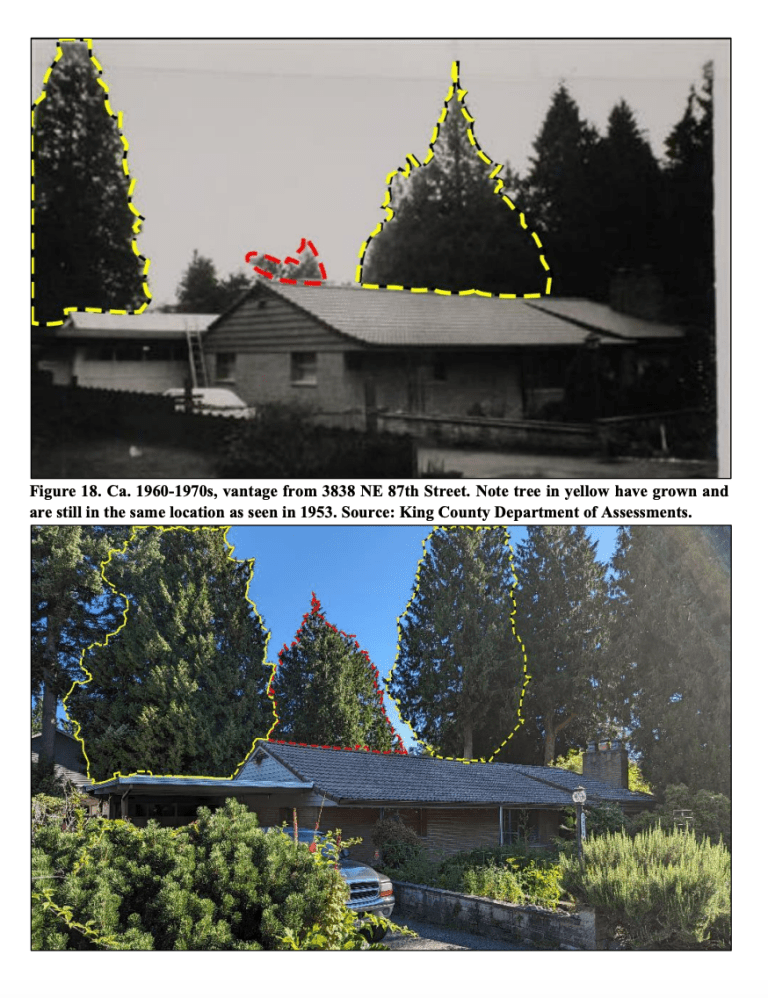Report: Wedgwood Tree Dubbed "Luma" Is Much Younger Than Claimed
Developers still have no plans to cut down the tree, which a new analysis concludes is closer to 85 years old.

By Erica C. Barnett
An independent report commissioned by a company that plans to build several townhouses in a historically single-family neighborhood in northeast Seattle suggests that a double-trunked Western red cedar tree in Northeast Seattle is around 85 years old, far shy of its widely reported age of “roughly 200 years old.” The tree, named “Luma” by activists, was designated a “culturally modified tree” after an in-person assessment by the Snoqualmie Tribe. According to one media report, “she,” meaning Luma, “was a sapling when white settlers arrived here.”
The newly released report, which is posted on the Seattle Department of Construction and Inspections’ website, calls that history into question. The analysis, by an independent cultural preservation firm called Drayton Archaeology, uses historical photos and a review of the history of development in the area to determine approximately how long the tree has been around. According to the report, the tree does not appear in aerial photos taken in 1936, and was “relatively small”—just starting to peek over an adjacent roofline in photos—in 1953.
By 1965, the report says, the tree was still “not tall enough to be fully present in the photo and does not appear to be of advanced age.” Western red cedar trees grow quickly, adding up to three feet of height a year in their natural forest habitat, and can grow to as much as 200 feet tall.
According to a letter the Snoqualmie Tribe sent to city officials in July, the cedar once served as a marker “that delineated an ancient indigenous trail system connecting Puget Sound to Lake Washington.” The letter adds that the Washington State Department of Archaeology and Historic Preservation independently reached the same conclusion.
However, the head of the DAHP, Allyson Brooks, said it’s up to tribes, not the state of Washington, to decide what constitutes a culturally modified tree. As an archaeological agency, she said, “We see artifacts. We know what an artifact is. But the question about culturally modified trees is one of culture for the tribes.” The Snoqualmie Tribe did not respond to an email seeking comment.
A comparison of old aerial photos showing three different trees in the location where Luma now stands, along with other historical images, suggests that the tree “was not extant in 1936 but may have been planted shortly after, as it had grown large enough by 2021 that its canopy encompassed the space formerly occupied by the three smaller trees.” The tree is now about 80 feet tall.
“Based on this information, it is my opinion that the subject red cedar tree was not extant in 1936,” the report continues. If the tree was planted that year, it would be 87 years old today.
According to the website Wedgwood History, the oldest houses still standing in Wedgwood were built around the turn of the 20th century, and the neighborhood had electricity by around 1923. By the mid-1930s, Wedgwood was a developed area, with paved roads and houses (as well as a county-endorsed racist covenant that banned all non-white people, except live-in servants, from living in the area). If the report’s estimate of Luma’s age is accurate, the property where it sits would have already been developed and occupied when the tree was a sapling.
Regardless of the age of the tree, the developers aren’t arguing to remove it; they’ve submitted new plans to the city that reduce the proposed housing on the lot from three townhouses to a new single-family house with a small backyard unit.
Seattle’s tree preservation ordinance includes protections for exceptional trees, a category that includes all very large trees, regardless of age. Luma’s unusually large diameter—52 inches, according to a separate arborist’s report—is based on a formula that combines its two separate trunks; other single-trunked exceptional Western red cedars in the immediate vicinity are between 30 and 42 inches in diameter. Exceptional trees can only removed with permission from the city under certain limited circumstances.
Asked about the consultant’s report, Brooks, from DAHP, said the agency “cannot comment on an unofficial report to our agency that was sent to us by a third party.”






I don't even know what to believe anymore. There's no hope for society if the tree huggers and hippies are lying to protect restrictive zoning.